How Did Cuba Make It Online ?
28 August 2018 - Otaviano Canuto, Samuel George Dual transitions are under way in Cuba. The island is slowly opening its economy, and a new crop of younger political…
28 August 2018 - Otaviano Canuto, Samuel George Dual transitions are under way in Cuba. The island is slowly opening its economy, and a new crop of younger political…
Rank #4: The Future of International Trade and Global Governance Aug 14 2017 Otaviano Canuto (World Bank) Otaviano Canuto, Executive Director at the World Bank, is discussing the future…

COMO REJUVENESCER A INDÚSTRIA BRASILEIRA Meu artigo anterior me gerou comentários de estar menosprezando a relevância da indústria manufatureira para a produtividade e o crescimento econômico brasileiro. Tê-lo-ia feito tanto por…
Otaviano Canuto, World Bank on Trade and Governanceat SOAS University of London. https://www.facebook.com/econ.plus/videos/1436406076414654/
15 July 2017 - Otaviano Canuto, Aleksandra Liaplina The world economy – and emerging market and developing economies in particular – display a gap between their infrastructure needs and the…
O FETICHISMO DOS PRODUTOS Caso não venhamos a superar o desempenho pífio da produtividade média do trabalhador brasileiro das últimas décadas não poderemos sonhar com crescimento econômico sustentado e socialmente inclusivo.…
A produtividade total do trabalho e dos fatores (PTF) no Brasil apresentou aumentos anêmicos nas últimas décadas. Ao contrário da visão comum, as estruturas setoriais do produto interno bruto (PIB) e do emprego brasileiros não podem ser identiicadas como as principais determinantes do desempenho da produtividade. Fatores horizontais e transversais que impedem aumentos de produtividade parecem ter mais peso.
Brazil’s labor and total-factor productivity (TFP) have featured anemic increases in the last decades (Canuto, 2016). As we illustrate here, contrary to common view, sector structures of the Brazilian GDP…
Interactions between access to finance, product innovation, and labor supply are studied in a two-period overlapping generations model with an endogenous skill distribution and financial market imperfections. In the model lack of access to finance (induced by high monitoring costs) has an adverse effect on innovation activity not only directly but also indirectly, because too few individuals may choose to invest in skills. If monitoring costs fall with the number of successful projects, multiple steady states may emerge, one of which defined as a middle-income trap, characterized by low wages in the design sector, a low share of the labor force engaged in innovation activity, and low growth. A sufficiently ambitious policy aimed at alleviating constraints on access to finance by innovators may allow a country to move away from such a trap by promoting the production of ideas and improving incentives to invest in skills.
Otaviano Canuto, Executive Director at the World Bank, once again is with ECON+ to continue this series of interviews on the global economy. This time, we tackle the topic…
One major policy issue in Brazil is how to boost productivity, while following a path of fiscal consolidation that will take at least a decade to bring the public-debt-to-GDP…
PILARES PARA O FINANCIAMENTO DE LONGO PRAZO NO BRASIL O financiamento de longo prazo na economia brasileira é peculiar. De um lado, agentes privados preferem aplicar em títulos públicos,…
The Heat: Crisis in Brazil Pt 3 CGTN America Published on Jun 1, 2017 It was less than a year ago when then Brazilian President Dilma Rousseff was removed from…
Interactions between access to finance, product innovation, and labor supply are studied in a two-period overlapping generations model with an endogenous skill distribution and financial market imperfections. In the model lack of access to finance (induced by high monitoring costs) has an adverse effect on innovation activity not only directly but also indirectly, because too few individuals may choose to invest in skills. If monitoring costs fall with the number of successful projects, multiple steady states may emerge, one of which defined as a middle-income trap, characterized by low wages in the design sector, a low share of the labor force engaged in innovation activity, and low growth. A sufficiently ambitious policy aimed at alleviating constraints on access to finance by innovators may allow a country to move away from such a trap by promoting the production of ideas and improving incentives to invest in skills.
Canuto e Pedro Cristo debatem políticas públicas em realidades complexas Fecomercio SP Published on May 26, 2017 Otaviano Canuto, diretor executivo do Banco Mundial, e Pedro Henrique de Cristo,…